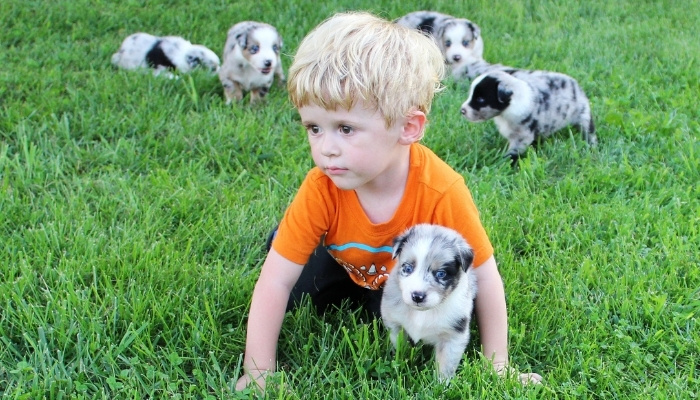There are several reasons why young children engage in humping behavior:
– Some do it as a form of self-soothing or comfort.
– Others may do it out of curiosity or exploration.
– Some may imitate what they see adults doing.
– In some cases, it may be a sign of sexual abuse or exposure to inappropriate behavior.
- To self-soothe
- To relieve stress
- Enjoyment of the sensation
- Normal development and bodily exploration
- Seeking attention
- Imitation of others
- Boredom
- Genital irritation
- As a result of exposure to sexual imagery or abuse
In most cases, the behavior is not a cause for concern, but if it continues, consider talking to your child about appropriate behavior and touching.
Humping and genital touching can occur for numerous reasons and at various ages/stages.
Humping by toddlers is typically a “self-soothing” behavior but in some cases may evolve into attention-seeking or stress-relieving behavior.
The National Child Traumatic Stress Network shares this:
“In fact, these behaviors are much more likely to be related to anxiety, traumatic experiences, curiosity, poor impulse control, or other factors.”
I have found that once the root cause is addressed and dealt with appropriately, the behavior disappears quickly.
Table of Contents
9 Reasons Why Toddlers Hump
Despite your embarrassment, this behavior is normal, and you are not alone.
Reasons for humping behavior vary among children, and within my own extended family and circle of friends, I have witnessed the behavior repeatedly.
Humping behavior can present for a single reason or a combination of reasons.
Reasons for toddler humping include self-soothing, stress relief, enjoyment, natural developmental phase, imitation, boredom, genital irritation, and exposure to sexual images/abuse.
1. Self-Soothing Behavior
If you notice humping behaviors occurring at rest times, such as naps and bedtime, your child is most likely using humping as a form of self-soothing.
Often in times of anxiety or exhaustion, humping is used in a rhythmic motion to help soothe and calm the body.
If you are noticing a behavior pattern during times of exhaustion or anxiety, try replacing the behavior with a more desirable one.
Address and resolve the issue that is causing your child to self-soothe.
If your child is humping a favorite stuffed animal or object when tired, simply removing the object could stop the behavior.
Humping as a form of self-soothing usually stops on its own as a child matures.
2. To Relieve Stress
Toddlers react to stress and have several stress triggers, including transition, life changes, a new addition to the family, and social gatherings.
Toddlers, like adults, need to relieve stress. Humping, genital touching, or genital pulling may be used as a form of stress relief.
These behaviors may be combined into a more complex form of self-soothing stress relief.
If you notice a pattern in the behavior or your child is using humping in moments of stress, try distracting them or replacing the behavior with a more desirable activity.
Giving your child the tools to self-soothe in times of high stress and anxiety will promote positive mental health as they grow and develop.
3. They Enjoy the Sensation
Children discover that humping feels good, and they often continue to do it. Childhood sexual exploration peaks at age 5.
Children may be humping merely because it offers satisfaction and enjoyment. It is only sexual if you make it sexual.
Teaching your child that touching their body should be done in private, like going to the bathroom, can help prevent the embarrassment of the behavior happening in public.
With your help and time, children can learn discretion and develop appropriate behavior patterns.
4. Normal Part of Development and Exploration
Children naturally are curious about their bodies, and the sensation that humping causes might encourage them to continue the behavior.
All children at some point explore their bodies and the various sensations caused by touch in one way or another.
In most cases, this is completely harmless and is even considered to be a healthy form of curiosity.
5. Seeking Attention
It is not at all uncommon for toddlers to actively seek attention. They enjoy being the focus of attention, and some don’t seem to care whether the attention is good or bad.
Maybe you’ve caught your child humping before, and your son or daughter enjoyed the shocked look on your face.
Perhaps your little one saw a playmate draw a crowd of onlookers while humping and wanted the same amount of attention.
Humping simply to get attention can easily be corrected by talking to your child and ensuring he or she receives enough quality time with you each day and understands the proper way to seek attention when needed.
6. Imitation of Others
Copying behaviors witnessed either in person or through various media could be the cause behind your toddler’s humping.
If you believe that your little one might have seen something sexual in nature, encourage him or her to share what they witnessed, and help them make sense of what they experienced and are feeling.
7. To Relieve Boredom
Children can and will do many things to entertain themselves when boredom strikes.
Humping people or objects may very well be nothing more than an attempt at relieving boredom.
Perhaps they saw another child engage in the behavior and thought it looked like fun, or maybe they enjoy the sensation that humping provides and simply have nothing better to do.
Offering a distraction or some form of entertainment is usually enough to end the behavior.
8. Gential Irritation
Humping could be your toddler’s way of dealing with the itch or discomfort of a rash, bug bite, or infection in their private region.
Rule out these common issues first before exploring other possible causes.
9. Exposed to Inappropriate Images or Sexual Abuse
Humping due to exposure to adult materials and/or sexual abuse is uncommon; however, it needs to be addressed.
If you notice your toddler humping or touching other children, pets, or people inappropriately and/or secretly, talk to your child.
It is possible that your child is imitating a behavior he or she witnessed or was forced to take part in. If you feel this may be the case, seek professional help for your child right away.

When To Be Concerned With Toddler Humping
Toddler humping is a prevalent and normal childhood behavior. Despite being a common behavior, there are times when you should be concerned.
1. It Becomes an Obsession
If your child spends a lot of time and energy on humping and overly sexualized behavior, it can become concerning.
If the behavior begins to interfere with friendships, school, and relationships, it is an obsession.
It is important to intervene calmly and consistently, addressing the behavior from a standpoint of privacy and appropriateness.
2. It Involves Another Person
If your child’s behavior involves another person, whether a sibling, peer, or adult, it is a red flag.
If the behavior becomes coercive or repetitive despite repercussions, it could be a sign that your child may have a more serious problem and may require professional intervention.
3. Other Signs of ADHD or Autism Are Present
Three key areas of childhood autism and ADHD include the quality of reciprocal behaviors, communication/language, and repetitive, limited, or unfocused interests and behaviors.
If you notice a developmental delay in any of these key areas in addition to your child’s humping behavior, talk to your primary care physician to seek support for your child.
4. Displays Other Signs of Sexual Abuse
If you notice your child having detailed age-inappropriate sexual knowledge, attempting to touch others’ private areas, or showing signs of sexual activity, talk to your child, and discover where your child learned the information.
Most children who have been victims of sexual abuse will have extreme behavior changes including depression, hesitancy to undress, avoidance of touch, and hyper-vigilance.
It is uncommon for victims of sexual abuse to engage in humping behavior, but it is possible.
It is important to remember that the signs of sexual exploration differ significantly from the signs of abuse.
How To Handle the Situation
If the humping behavior becomes concerning, the best course of action is to talk to your primary care physician and seek support through professional interventions and techniques.
- Teach your child appropriate behavior, and talk about safe touch.
- Do not shame your child.
- Approach your child calmly, compassionately, and firmly.
- Focus on teaching your child about privacy and respecting boundaries.
Mom of three (including identical twin boys), wife, and owner of Parents Wonder. This is my place to share my journey as a mother and the helpful insights I learn along the way.

